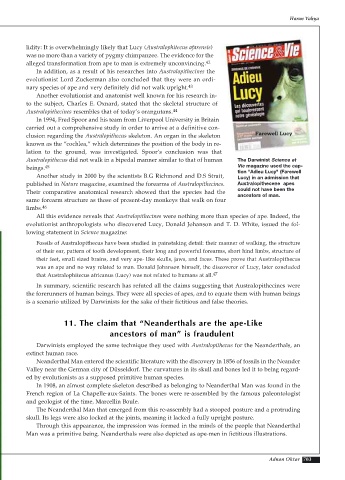Page 785 - Atlas of Creation Volume 4
P. 785
Harun Yahya
lidity: It is overwhelmingly likely that Lucy (Australophitecus afarensis)
was no more than a variety of pygmy chimpanzee. The evidence for the
alleged transformation from ape to man is extremely unconvincing. 42
In addition, as a result of his researches into Australopithecines the
evolutionist Lord Zuckerman also concluded that they were an ordi-
nary species of ape and very definitely did not walk upright. 43
Another evolutionist and anatomist well known for his research in-
to the subject, Charles E. Oxnard, stated that the skeletal structure of
Australopithecines resembles that of today’s orangutans. 44
In 1994, Fred Spoor and his team from Liverpool University in Britain
carried out a comprehensive study in order to arrive at a definitive con-
clusion regarding the Australopithecus skeleton. An organ in the skeleton Farewell Lucy
known as the “cochlea,” which determines the position of the body in re-
lation to the ground, was investigated. Spoor’s conclusion was that
Australopithecus did not walk in a bipedal manner similar to that of human The Darwinist Science et
beings. 45 Vie magazine used the cap-
tion "Adieu Lucy" (Farewell
Another study in 2000 by the scientists B.G Richmond and D.S Strait, Lucy) in an admission that
published in Nature magazine, examined the forearms of Australopithecines. Australopithecene apes
could not have been the
Their comparative anatomical research showed that the species had the
ancestors of man.
same forearm structure as those of present-day monkeys that walk on four
limbs. 46
All this evidence reveals that Australopithecines were nothing more than species of ape. Indeed, the
evolutionist anthropologists who discovered Lucy, Donald Johanson and T. D. White, issued the fol-
lowing statement in Science magazine:
Fossils of Australopithecus have been studied in painstaking detail: their manner of walking, the structure
of their ear, pattern of tooth development, their long and powerful forearms, short hind limbs, structure of
their feet, small sized brains, and very ape- like skulls, jaws, and faces. These prove that Australopithecus
was an ape and no way related to man. Donald Johanson himself, the discoverer of Lucy, later concluded
that Australophitecus africanus (Lucy) was not related to humans at all. 47
In summary, scientific research has refuted all the claims suggesting that Australopithecines were
the forerunners of human beings. They were all species of apes, and to equate them with human beings
is a scenario utilized by Darwinists for the sake of their fictitious and false theories.
11. The claim that “Neanderthals are the ape-Like
ancestors of man” is fraudulent
Darwinists employed the same technique they used with Australopithecus for the Neanderthals, an
extinct human race.
Neanderthal Man entered the scientific literature with the discovery in 1856 of fossils in the Neander
Valley near the German city of Düsseldorf. The curvatures in its skull and bones led it to being regard-
ed by evolutionists as a supposed primitive human species.
In 1908, an almost complete skeleton described as belonging to Neanderthal Man was found in the
French region of La Chapelle-aux-Saints. The bones were re-assembled by the famous paleontologist
and geologist of the time, Marcellin Boule.
The Neanderthal Man that emerged from this re-assembly had a stooped posture and a protruding
skull. Its legs were also locked at the joints, meaning it lacked a fully upright posture.
Through this appearance, the impression was formed in the minds of the people that Neanderthal
Man was a primitive being. Neanderthals were also depicted as ape-men in fictitious illustrations.
Adnan Oktar 783

